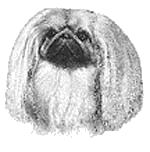
Most all people love dogs...they are man's best friend...but did you know that dogs have actually been important to the development of humans throughout history? They helped the cavemen to hunt and the early settlers to survive.
The extraordinary variety in shape, size, color and temperament of today’s dogs belies the fact that each is a member of the same species. Canis familiaris, our domestic dog, belongs to the greater Canidae family of 38 diverse species, keeping company, among others, with the beautiful gray wolf (Canis lupus) and the large-eared fennec fox (Fennecus zerda).
As humans learned to use arrows (and thus target prey from long distances), they came to need the skill of their dogs to track and bay the hunted animal. Cooperative hunting was thus discovered, beneficial for both the hunter and his helper.
Through the process of domestication, the wild precursor of today’s dog eventually lost his fear and grew more docile - at the same time experiencing physiological and anatomical changes such as reduced brain size and acuteness of hearing and sight. The domestic dog has also retained juvenile characteristics, including a dome-shaped skull and persistent, submissive behaviors.
Today there are over 400 recognized dog breeds throughout the world, varying from the diminutive Chihuahua to the stately and tall Irish Wolfhound. The first recognized unique “breed” was probably a lanky and swift greyhound-type of dog, used for its speed in hunting. Paintings and pottery depict this as one of the most ancient of foundation breeds. Intense artificial selection pressures imposed by humans changed the appearance - and behavior - of dogs quickly so that, by the time of the Roman Empire, most general breed types were already identifiable. In hunting alone, as its rules became more formalized, there were great differences in skill between the sight-hounds (such as the greyhound) and the scent-hounds (such as the beagle).

Probably the closest our domestic dog can come to her wild-type ancestors is in the “Spitz” or northern group, which includes the Malamutes and Huskies. While this group continues to excel in the ancient skills of hunting, guarding and pulling, other breeds have strayed, as it were, far from their original purpose. Most striking in this regard are the toy breeds, developed simply as lap dogs and companions.
Regardless of the purposes for which dogs were developed - whether hunting, guarding of the home or of livestock, herding, lap-sitting or simply social status - from the beginning their most compelling asset was faithful companionship. The enduring and unconditional friendship of the wolf was most likely evident that very first evening, when the very first curious wolf ventured into a cave, found a few scraps of meat and then laid his head on the knee of his new partner.

SMALL DOGS

We will also feature large dogs, hounds, sporting dogs and many
other types as well as articles relating to dog care. Pet Tales has
a section for Rescue as well and a Rainbow Bridge. Send any submissions
or suggestions to Ms Dixie.
Pet Tales Home
Pet Information Center
|